Recurrent CH HSS sparks G1 geomagnetic storming
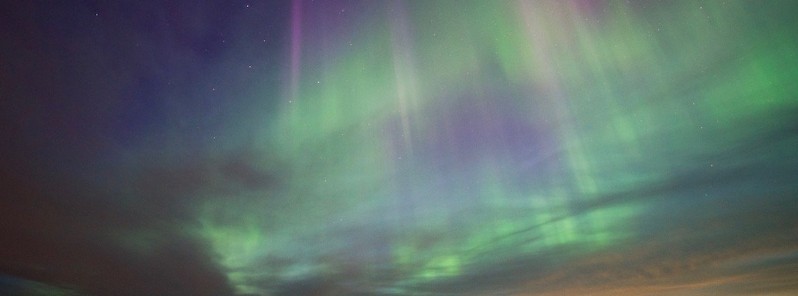
Earth is under the influence of a recurrent, negative polarity coronal hole high speed stream (CH HSS) today which is causing G1 – Minor geomagnetic storming.
Solar wind speed increased to 548 km/s at 08:08 UTC while total field reached a maximum of 16 nT at 07:16 UTC. The Bz component reached a maximum southward deflection of -13 at 07:16 UTC. Phi angle was variable during the past 24 hours until 05:10 UTC when it switched to mostly negative (towards) sector.
Solar wind parameters are expected to continue to be enhanced under a negative polarity CH HSS over the next three days (June 16 – 18).
Geomagnetic K-index of 4 threshold was reached at 08:44 UTC. Geomagnetic K-index of 5 (G1 – Minor geomagnetic storm) threshold was reached 6 hours later, at 14:58 UTC.
Under G1 conditions, area of impact is primarily poleward of 60 degrees Geomagnetic Latitude, weak power grid fluctuations can occur, minor impact on satellite operations is possible, aurora may be visible at high latitudes.
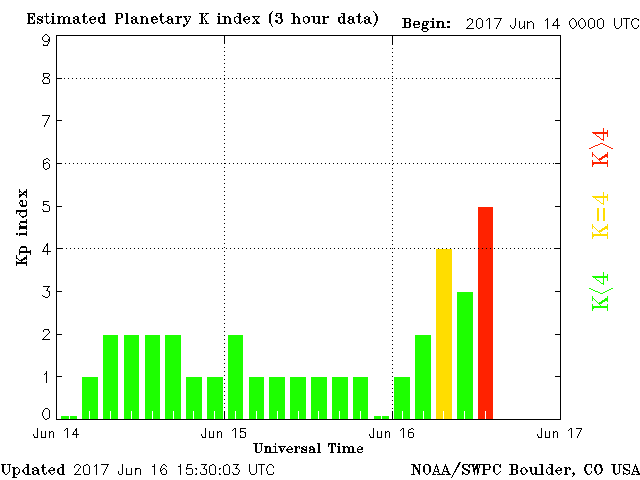
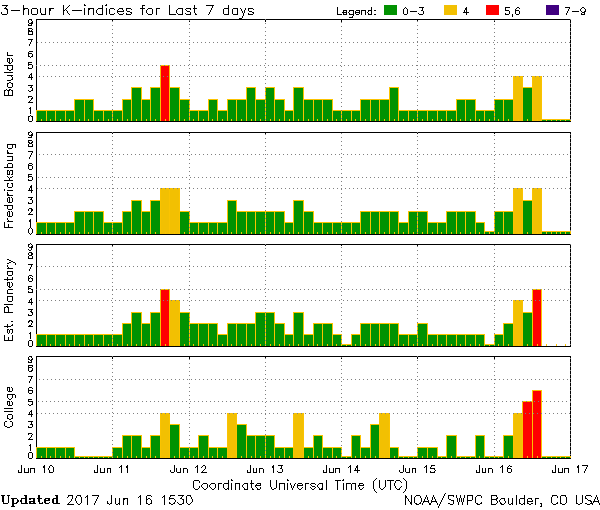
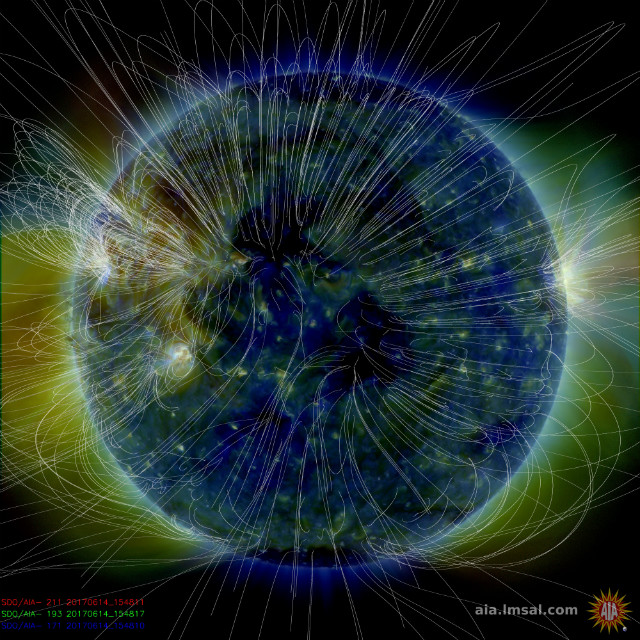
Coronal holes as seen on June 14, 2017 . Credit: NASA SDO/AIA, LMSAL
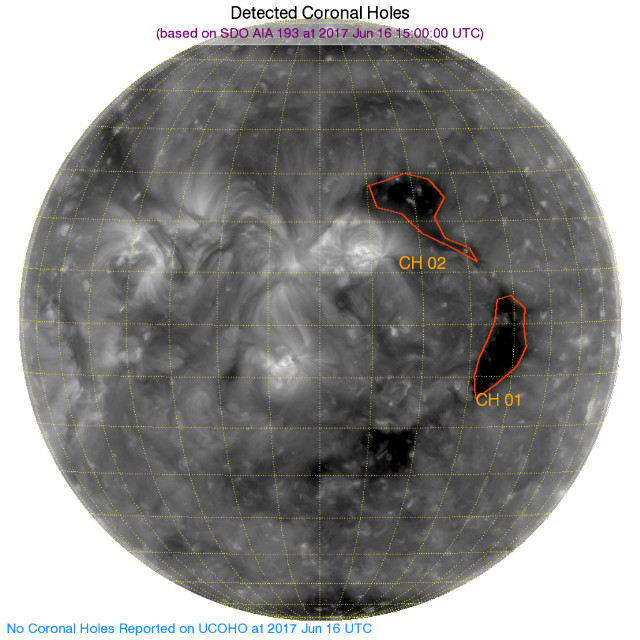
Detected coronal holes on June 16, 2017. Credit: KSWC/ASSA, NASA SDO/AIA
Unsettled to G1 geomagnetic storm levels are expected for the rest of the UTC day due to persistent CH HSS effects. Unsettled to active conditions are expected to continue through June 17 with quiet to unsettled levels likely on June 18 as influence from the CH HSS slowly wanes.
#Aurora and #fireflies compete and against #twilight and the waning moon tonight from Andrew AB. @coryedelCTV @RobWilliamsCTV @AuroraMAX pic.twitter.com/wVJfRBETlG
— Images By Stan (@ImagesByStan) June 16, 2017
Stunning display of pink #Aurora this morning June16/17 near Alix Alberta! #teamtanner @treetanner @weathernetwork @TamithaSkov @mikesobel pic.twitter.com/cPDXXdwIF2
— Darlene Tanner (@dartanner) June 16, 2017
crackerjack southern lights @ 10.45 tonight! #auroraaustralis #tasmania pic.twitter.com/3Qi1QQHCP1
— §u (@SussanSays) May 28, 2017
SWPC alerts
Space Weather Message Code: ALTK05
Serial Number: 1117
Issue Time: 2017 Jun 16 1500 UTC
ALERT: Geomagnetic K-index of 5
Threshold Reached: 2017 Jun 16 1458 UTC
Synoptic Period: 1200-1500 UTC
Active Warning: Yes
NOAA Scale: G1 – Minor
NOAA Space Weather Scale descriptions can be found at
www.swpc.noaa.gov/noaa-scales-explanation
Potential Impacts: Area of impact primarily poleward of 60 degrees Geomagnetic Latitude.
Induced Currents – Weak power grid fluctuations can occur.
Spacecraft – Minor impact on satellite operations possible.
Aurora – Aurora may be visible at high latitudes, i.e., northern tier of the U.S. such as northern Michigan and Maine.
***
Space Weather Message Code: WARK04
Serial Number: 3234
Issue Time: 2017 Jun 16 1456 UTC
EXTENDED WARNING: Geomagnetic K-index of 4 expected
Extension to Serial Number: 3233
Valid From: 2017 Jun 16 0323 UTC
Now Valid Until: 2017 Jun 16 2359 UTC
Warning Condition: Persistence
NOAA Space Weather Scale descriptions can be found at
www.swpc.noaa.gov/noaa-scales-explanation
Potential Impacts: Area of impact primarily poleward of 65 degrees Geomagnetic Latitude.
Induced Currents – Weak power grid fluctuations can occur.
Aurora – Aurora may be visible at high latitudes such as Canada and Alaska.
***
Space Weather Message Code: WARK05
Serial Number: 1360
Issue Time: 2017 Jun 16 1456 UTC
EXTENDED WARNING: Geomagnetic K-index of 5 expected
Extension to Serial Number: 1359
Valid From: 2017 Jun 16 0843 UTC
Now Valid Until: 2017 Jun 16 2359 UTC
Warning Condition: Persistence
NOAA Space Weather Scale descriptions can be found at
www.swpc.noaa.gov/noaa-scales-explanation
Potential Impacts: Area of impact primarily poleward of 60 degrees Geomagnetic Latitude.
Induced Currents – Weak power grid fluctuations can occur.
Spacecraft – Minor impact on satellite operations possible.
Aurora – Aurora may be visible at high latitudes, i.e., northern tier of the U.S. such as northern Michigan and Maine.
***
Space Weather Message Code: ALTK04
Serial Number: 1984
Issue Time: 2017 Jun 16 0844 UTC
ALERT: Geomagnetic K-index of 4
Threshold Reached: 2017 Jun 16 0844 UTC
Synoptic Period: 0600-0900 UTC
Active Warning: Yes
NOAA Space Weather Scale descriptions can be found at
www.swpc.noaa.gov/noaa-scales-explanation
Potential Impacts: Area of impact primarily poleward of 65 degrees Geomagnetic Latitude.
Induced Currents – Weak power grid fluctuations can occur.
Aurora – Aurora may be visible at high latitudes such as Canada and Alaska.
Featured image: Aurora against twilight and the waning moon – June 16, 2017. Image credit: Stan Cholak (via Twitter)

Commenting rules and guidelines
We value the thoughts and opinions of our readers and welcome healthy discussions on our website. In order to maintain a respectful and positive community, we ask that all commenters follow these rules:
We reserve the right to remove any comments that violate these rules. By commenting on our website, you agree to abide by these guidelines. Thank you for helping to create a positive and welcoming environment for all.